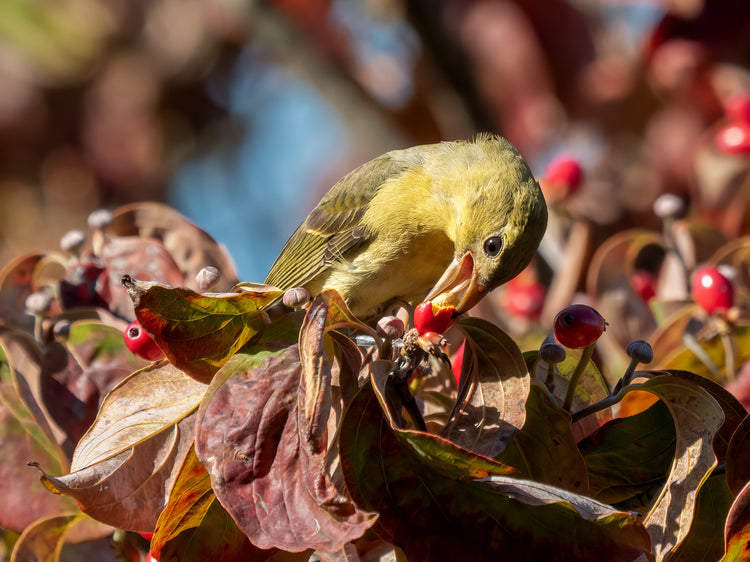“We need a new approach to urban landscapes, especially dull municipal plantings, where we can, with minimal input, create vibrant ecosystems that nourish wildlife, mitigate climate change and nurture our souls. This could be it.”
Mark Laurence, The New Shrubscape

This fall we planted a pocket forest in Meadowbrook Park. This was a special pocket forest, our very first pocket shrubland or thicket.
Vermont Fish & Wildlife defines a shrubland as:
“an area with high sunlight exposure that remains permanently in a state of low plant cover, ranging from herbaceous plants to woody plants less than 20 feet tall. Shrublands are nature’s pantry, providing myriad insects, fruits, seeds and nuts. Dogwoods, serviceberry, chokecherry, blueberry, blackberry, hazelnut, mountain holly, and wild cranberry are just a few of the numerous shrubs of high value to wildlife.”
Dense masses of fruiting shrubs, brambles, and vines are critical bird habitat. They offer nectar, buds, and insects for spring migrants. During nesting season, they provide safe nesting habitat. Early-ripening fruits such as Serviceberries, Blueberries, Raspberries, and Blackberries help fuel new bird parents and their leaves host the the Lepidoptera bird parents need to raise their nestlings. In fall, they offer fatty, fall-ripening fruits such as various Dogwood species, Spicebush, Mountain Ash, Pokeweed (a perennial, but looks like a shrub), and Sassafras as well as seeds such as Buttonbush and Hoptree. In winter, Nannyberries, Sumac, Hawthorn, Aronia, Bayberries, Roses, Red Cedar, and Crabapples offer critically important sustenance.
Interested in supporting birds? Think beyond the bird feeder. Think thickets. Christine Hanrahan, Fletcher Wildlife Garden, writes:
“Think thickets – Groups of trees and shrubs provide better wildlife habitat; even a small thicket of 3–5 trees underplanted with 3–6 shrubs is better than single trees spaced far apart. Variety is good. Different species provide different roosting and nesting habitats and also supply a greater variety of food, either directly by their fruits or indirectly by attracting a richer cocktail of insects. Thickets of a single species are not as attractive as those of mixed species.”
Here's what we planted in the Shrubland Pocket Forest at Meadowbrook Park.
Understory (14 plants)
Rhododendrites/Wikimedia Commons
- Red Mulberry (Morus Rubra) x3. Hosts 9 Lepidoptera. Early maturing fruits a magnet for many birds, including Rose-Breasted Grosbeak and Scarlet Tanager. Flowers and berries also attract insects which attract insectivorous birds.
- Pawpaw (Asimina triloba) x5 (plant in spring). Hosts 2 Lepidoptera including Zebra Swallowtail and Pawpaw Sphinx Moth. The Missouri Department of Conservation says that the fruit is relished by numerous bird species.
- Eastern Flowering Dogwood (Cornus florida) x3. Hosts 129 Lepidoptera. Fruits are popular with birds including Grosbeaks, Sparrows, Woodpeckers, Thrushes, Vireos, Tanagers, and some Warblers.
- Dotted Hawthorne (Crataegus punctata) x 3. Hosts 173 Lepidoptera. Spring flowers attract insects (which in turn attract insectivorous birds) and Hummingbirds) and the fall fruit attract a long list of birds.
Shrub layer (35 plants)

bryan ribelin/bryanribelin.com
- Aronia (Aronia melanocarpa) x3. Hosts 29 Lepidoptera. Spring flowers attract insects (which in turn attract insectivorous birds). Less protein content than other berries, though in winter when berries are scarce are eaten by various birds who may select them for their high antioxidant content.
- Winterberry (Ilex verticillata) x3. Hosts 45 Lepidoptera. The most common Winterberry consumers are Eastern Bluebird and Cedar Waxwing. Wood Thrushes and Catbirds will fuel up on their berries during fall migration.
- Highbush Blueberry (Vaccinium corymbosum) x5. Hosts 295 Lepidoptera. While blueberries attract many birds, they're a particular favourite of Cedar Waxwings.
- Hoptree (Ptelea trifoliata) x3. Hosts 6 Lepidoptera, including Giant Swallowtail Butterfly. Provides important habitat for many birds, though most birds avoid the clusters of bitter-tasting fruit.
- Buttonbush (Cephalanthus occidentalis) x11. Hosts 19 Lepidoptera. Attracts more than 24 species of birds, including Hummingbirds for the nectar.
- Red Osier Dogwood (Cornus sericea) x8. Hosts 129 Lepidoptera. Small flowers attract insects which attract insectivores. Birds love the white berries, including Goldfinches, Robins, Thrashers, Cedar Waxwings, Bluebirds, Catbirds, Cardinals, Flickers, Finches, and Mockingbirds.
- Spicebush (Lindera benzoin) x2. Hosts 12 Lepidoptera including Spicebush Swallowtail. In spring Spicebush blooms small but fragrant yellow flowers, which attract insects (which will in turn attract insectivorous birds). Small red berries, with their high fat content, are particularly attractive to fall migrants. May be the best shrub for attracting Veery and Wood Thrush.

Bill MacIndewar/iNaturalist
Next year we'll be expand the planting with additional Spicebush, Winterberry, and Aronia, and adding in Wild Plum (Prunus americana), Pokeweed (Phytolacca americana), Blackberries (Rubus allegheniensis spp.), Elderberry (Sambucus), and more!
"I feel like the Lorax—I speak for the shrubs, because the shrubs have no tongue... Which birds stand to gain? On the coast it's every single migratory songbird [who benefit from shrublands]... There's at least 35 species of Warblers, five or six species of Vireos, all the Thrushes, Flycatchers—everything depends on the shrublands as they move south."
Scott Comings, How one underappreciated habitat is a boon for the birds
For more inspiration, check out our posts:


